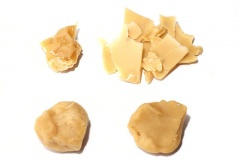Difference between revisions of "Candelilla Wax"
| Line 1: | Line 1: | ||
{{Infobox_Other_organic | {{Infobox_Other_organic | ||
| − | | image = | + | | image = candelillawax.jpg |
| origin = - | | origin = - | ||
| stowage factor = - | | stowage factor = - | ||
Revision as of 15:19, 12 April 2012
| Infobox on Candelilla Wax | |
|---|---|
| Example of Candelilla Wax |  |
| Facts | |
| Origin | - |
| Stowage factor (in m3/t) | - |
| Humidity / moisture | - |
| Ventilation | - |
| Risk factors | - |
Candelilla Wax
Contents
Description
A hard brown wax, obtained from the plant Pedilanthus pavonis.
With a melting point of 68.5–72.5 °C, candelilla wax consists of mainly hydrocarbons (about 50 %, chains with 29–33 carbons), esters of higher molecular weight (20–29 %), free acids (7–9%), and resins (12–14%, mainly triterpenoid esters). The high hydrocarbon content distinguishes this wax from Carnauba Wax. It is insoluble in water, but soluble in many organic solvents such as acetone, chloroform, benzene.
The wax is obtained by boiling the leaves and stems with dilute sulfuric acid, and the resulting "cerote" is skimmed from the surface and further processed.
It is mostly used mixed with other waxes to harden them without raising their melting point. As a food additive, candelilla wax is used as a glazing agent. It also finds use in cosmetic industry, as a component of lip balms and lotion bars. One of its major uses was a binder for chewing gums.
Candelilla wax can be used as a substitute for Carnauba Wax and beeswax. It is also used for making varnish.
It is subject to loss in weight due to chafing and seepage from packaging.
Full information on this product is in the process of completion.











